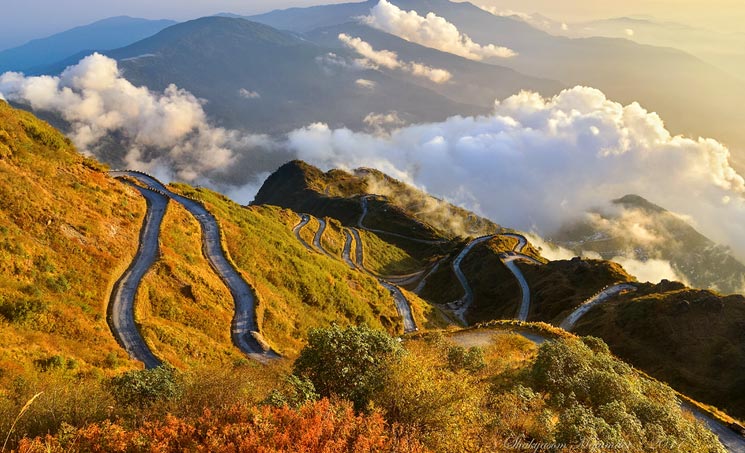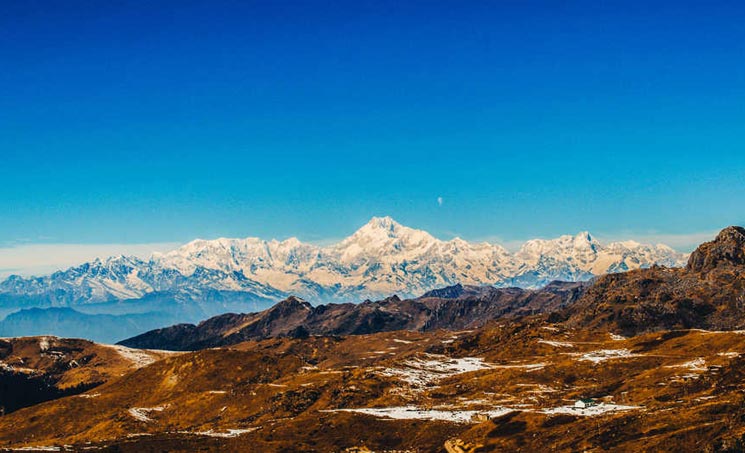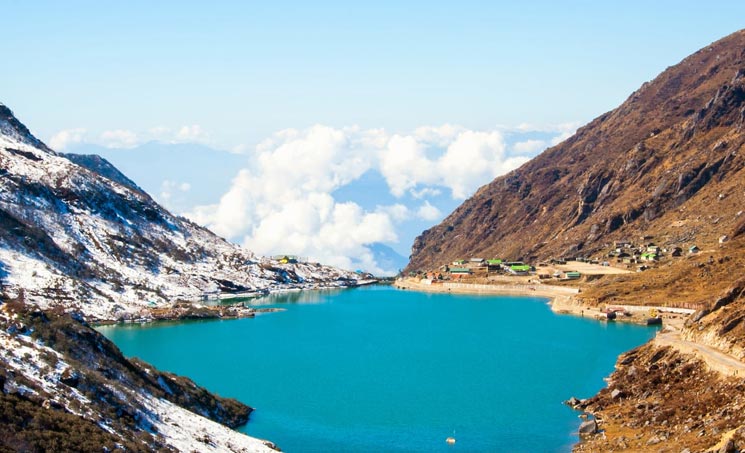East Sikkim



The Eastern part of Sikkim, also known as East Sikkim, is the center of cultural, economic, and tourism activities in the Indian state of Sikkim. It occupies the Southeast corner of the region and boasts a temperate climate, making it a year-round destination for the travelers to visit. The area is surrounded by lush forests that are home to some of the most exquisite Himalayan flora and fauna. Additionally, the district has well-paved routes that make it easier to explore the heart of Sikkim compared to other regions. East Sikkim is also home to Nathu La, a trading point with China and an ancient silk route. Know which are the best places to visit in East Sikkim before planning your trip there.
Talk to a Specialist
We agree, a conversation with an expert makes for a better trip. Call us or Email us now.
Call +91 97320 57478
Between 11 AM and 7 PM IST from Monday to Saturday
Email us at info@kanchenjungaholidays.com
Enquiry
Places to visit in East Sikkim
In East Sikkim, travelers get to see alluring places equipped with countless tourist attractions. Here, have a look at some of the most popular places to visit in East Sikkim.

Aritar
Aritar is a scenic paradise situated 63 km away from Gangtok. It is situated at an altitude of 4,914 ft. Its rich flora and fauna and the verdant forested area with lofty mountains make it a popular destination among nature lovers. Aritar is located on the edge of the Himalayas and offers an unobstructed view of Kanchenjunga. The Lampokhari Lake is a major attraction of Aritar, with its emerald green boot-shaped lake that allows visitors to partake in boating and horse riding. Visitors can also explore the thickly wooded forest surrounding Aritar, which has numerous nature trails leading to some of the most picturesque and historic sites like the Dak Bungalow. Constructed in 1895 under the command of Sir James Claude White, this bungalow was the first treasury of Sikkim. It still holds the essence of the British era. A visit to Aritar is a must for anyone traveling to Sikkim.
Aritar has many nature trails, including one that leads to Mankhim hill, which has a sacred temple dedicated to the gods and goddesses of the Rai. Visitors can also hike to Aritar Gompa. It one of the oldest and most revered monasteries in Sikkim, belonging to the Kagyu sect order. The monastery is adorned with ancient paintings, masks, and carvings. The nature trails around Lampokhari Lake are renowned for their collection of Himalayan Avifauna, making Aritar a birding paradise for the bird lovers. Travelers can also witness the majestic Kali Khola waterfall, which stands 328 ft tall and is situated on the Rorathang-Rongli road. The thick woods of alpine trees provide a musky fragrance, while the melodious chirping of various birds fills the ears, making Aritar a perfect destination for nature lovers.

Tsongmo Lake
Tsomgo Lake, also known as Chhangu Lake, is a sacred glacial lake situated in East Sikkim. Located 40 km away from Gangtok, the oval-shaped lake is perched at an altitude of 12,313 ft and remains frozen during the winter season, offering a mesmerizing view to the visitors. Tsomgo Lake is associated with many myths and rituals and is considered a revered destination by the locals. The lake is 836 meters long with a maximum width of 427 meters, and its maximum depth is 49 ft with an average depth of 15 ft. During summer and autumn, visitors can enjoy the Primulas and other Alpine vegetation around the lake. According to one of the legends, in ancient times, monks used to forecast the future by studying the color of the sacred lake.
Tsomgo Lake is a must-visit destination for anyone traveling to Sikkim. It indeed offers a unique and unforgettable experience. Tsomgo Lake is a very beautiful and fascinating destination. It is especially for those interested in nature, mythology, and spirituality. It is also considered to be a sacred site. The opportunity to ride decorated yaks and spot rare species like migratory Brahmini ducks also adds to the appeal of the destination. It seems that visitors to Tsomgo Lake can enjoy a mix of adventure, natural beauty, and cultural significance. In short, it is undoubtedly one of the best places to visit in East Sikkim.

Zuluk
Zuluk, an isolated hamlet situated in East Sikkim on the rugged terrain of the Lower Himalayas, can be found nestled in the world’s first statistical superhighway, the Silk Route, at an altitude of 10,100 ft. This hamlet, located beside the iconic 32 hairpin bend road, is the first on the Silk Route circuit to offer home stay facilities with basic amenities, making it a popular base for exploring the historic Silk Route. Despite being engulfed by the harsh cold winds of the Himalayan range, Zuluk has a few places of interest with some of the most pictorial sights, and it remains one of the less-trodden destinations in East Sikkim.
If you go 14 kilometers from the quiet village of Zuluk, you’ll find Thambi View Point, which is a great place to see the stunning sunrise over the snow-covered walls of Mount Kanchenjunga and the sweeping view of the famous 32-hairpin bend of East Sikkim. If you go further up from Thambi View Point, you’ll come across a beautiful natural lake called Kupup Lake, which is shaped like an elephant. Locally known as Bitan Cho, this is one of the most sacred lakes in Sikkim, surrounded by colorful prayer flags and offering a peaceful atmosphere in the charming Himalayan village of Zuluk. This is the perfect destination for travelers looking for solitude in the rugged mountainous terrain of the Himalayas, and an opportunity to explore the hidden valleys of Eastern Sikkim while on their journey to Zuluk.

Nathula
Located 54 km away from Gangtok on the historic Silk Route, Nathula or Nathu La is a significant mountain pass of the Himalayas. The word ‘Nathu’ means ‘listening ears’ in Tibetan, while ‘la’ refers to a ‘mountain pass’. Sitting at an altitude of 14450 ft, Nathula is the highest motorable point in East Sikkim and is surrounded by a variety of rhododendron trees and shrubs. Positioned on the way to Tsomgo (Chhangu) Lake, Nathula serves as an essential corridor between India and Tibet. Unfortunately, the passage was closed after the Nathu La and Cho La clashes between India and China in 1967. However, it reopened after nearly four decades on 6th June 2006.
When the sky is clear, visitors can catch sight of the Tibetan Plateau and Chumbi valley from Nathula, a crucial mountain pass of the Himalayas located 54 km from Gangtok on the historic Silk route. Nathula, which means ‘listening ears’ in Tibetan, is situated at an altitude of 14450 ft and is surrounded by rhododendron trees and shrubs. Only visitors of Indian nationality are allowed to visit Nathula on specific days of the week, which are Wednesday through Sunday. Travelers can also take a trip to Old Baba Mandir, a sacred shrine dedicated to the Sepoy Harbhajan Singh, which is located 6 km away from Nathula. As visitors journey to Nathula, the changing landscape is an added charm to the whole trip. From subtropical forest to the wet alpine region, the view transforms slowly as the spiraling road leads you towards the cold tundra region. The adjacent valley and the scenic paved road provide a stunning view, making Nathula a prime attraction of East Sikkim.

Gangtok
Gangtok, the capital city of Sikkim, is surrounded by dense deciduous forests of pine and conifer trees and is also the most populous city of the state. Located at an altitude of 4,435 ft, Gangtok has a rich history and was once the fourth capital of the Kingdom of Sikkim. The journey to Gangtok is a beautiful experience, as it offers a glimpse of the diverse ethnic culture and natural beauty of the region. Gangtok is home to many picturesque destinations, among which the most popular is M G Marg. Situated in the heart of the bustling city, M G Marg is a pedestrian-only zone and a popular hangout spot for locals and travelers alike, with its long benches, cafes, and restaurants. Another famous attraction of Gangtok is Inchey Monastery, which overlooks the city. Built in 1840, it has become a sacred Buddhist pilgrimage site and is dedicated to the protector deities of Kanchenjungha, Mahakala, and Yabdean. The festive season from December to March is considered the best time to visit Inchey Monastery.
Gangtok has a lot of exciting attractions for visitors to explore. One of the major attractions is the Banjhakhri Falls and Energy Park. The park is located in a forested area of Swastik, about 7 km from Gangtok. It’s named after the shamanic healers of Sikkim, and features a natural waterfall sourced from springs. Another must-visit destination in Gangtok is the Namgyal Institute of Tibetology, a world-renowned research institute dedicated to the study of Tibetan language and culture. The Hanuman Tok, a temple dedicated to Lord Hanuman, is also a popular attraction due to its breathtaking views of the world’s third-highest peak, Mt. Kanchenjunga.
If you’re looking for a bird’s eye view of Gangtok, take a ride on the Rope Way from Deorali Bazaar. The Botanical Garden is another great spot to visit and features a beautiful collection of trees and plants with their scientific names. Other notable attractions in Gangtok include Tashi view point, Ganesh Tok, and the Zoological gardens. A visit to Rumtek Monastery, the most famous monastery of the Kagyu Pa sect of Tibetan Buddhism, is also a must. This grand monastery features impressive Tibetan architecture, and the Golden Stupa is a particularly striking feature. On the way to the Dharma Chakra Centre or Rumtek Monastery, visitors can also explore the Dro-dul Chorten, a huge stupa built in 1946 to ward off evil. With so many exciting destinations to explore, Gangtok is a city that truly has something for everyone.

Jeep La
With an approximate height 1400 feet above the sea level, Jelep La is one of the highest passes in Sikkim. This particular pass connects Tibet’s Lhasa with India. So, if you’re planning a trip to East Sikkim, you definitely don’t want to miss out on Jelep La Pass. It’s a great spot to take in some truly breathtaking views of the Chumbi Valley and the Tibetan Plateau. As you drive along the winding road, you’ll even get to see Tsomgo Lake and Nathula Pass up close. And even though the drive can be a bit challenging, it’s totally worth it! Jelep La Pass is definitely one of the best tourist spots in East Sikkim.
In India, Jelep La pass has two routes, one passing through Kalimpong and the other through Gangtok. The Kalimpong route, which is the older one, goes through the charming towns of Pedong in the northern part of West Bengal, Rhenok, and Kupup. This route played a significant role in the local economy as it was used for trading furs and wool until the early 20th century. Unfortunately, the route was closed down after the Sino-Indian War in 1962. The Gangtok route, on the other hand, goes through the towns of Sherathang, near Changu Lake, and along Nathu La, before crossing Kupup.